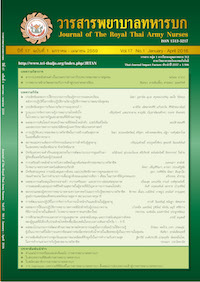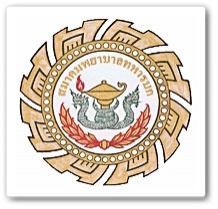การศึกษาพฤติกรรมแสวงหาการดูแลสุขภาพ แหล่งสนับสนุน และการสนับสนุนทางสังคมของผู้ดูแลที่มีเด็กเจ็บป่วยด้วยโรคติดเชื้อ เฉียบพลันในระบบทางเดินหายใจวัย 1 - 5 ปี
Keywords:
การสนับสนุนทางสังคม, พฤติกรรมแสวงหาการดูแลสุขภาพ, แหล่งสนับสนุน, Social Support, caregiver, Resources, health care seeking behaviorAbstract
การวิจัยครั้งนี้เป็นการวิจัยเชิงบรรยาย (Descriptive research) เพื่อศึกษาพฤติกรรมแสวงหาการดูแลสุขภาพ แหล่งสนับสนุน และการสนับสนุนทางสังคมของผู้ดูแลที่มีเด็กเจ็บป่วยด้วยโรคติดเชื้อเฉียบพลันในระบบทางเดินหายใจ ตลอดจน หาความสัมพันธ์ระหว่างการสนับสนุนทางสังคมกับพฤติกรรมแสวงหาการดูแลสุขภาพของผู้ดูแลที่มีเด็กป่วยเป็นโรคติดเชื้อเฉียบพลัน ในระบบทางเดินหายใจอายุ 1 - 5 ปี จำนวน 221 ราย เครื่องมือที่ใช้ในการเก็บรวบรวมข้อมูลคือ แบบสัมภาษณ์เกี่ยวกับการสนับสนุน ทางสังคม และแบบสัมภาษณ์พฤติกรรมแสวงหาการดูแลสุขภาพของผู้ดูแล และตรวจหาความเชื่อมั่นด้วยสูตรอัลฟาครอนบาค เท่ากับ 0.74 วิเคราะห์ข้อมูลโดยการหาค่าความถี่ เปอร์เซ็นต์ ค่าเฉลี่ย และค่าเบี่ยงเบนมาตรฐาน และหาความสัมพันธ์ระหว่าง การสนับสนุนทางสังคมกับพฤติกรรมการแสวงหาการดูแลสุขภาพ
ผลการศึกษา พบว่า
1. ผู้ดูแลที่มีเด็กเจ็บป่วยได้รับการสนับสนุนทางสังคมโดยรวมทั้ง 4 ด้าน ได้แก่ ด้านอารมณ์ ด้านการประเมิน ด้านข้อมูล และด้านทรัพยากร โดยมีค่าเฉลี่ย 3.28 ค่าเบี่ยงเบนมาตรฐาน 0.344 เมื่อพิจารณารายด้านพบว่า ด้านการประเมินมากที่สุด มีค่าเฉลี่ย 3.36 ค่าเบี่ยงเบนมาตรฐาน 0.544 รองลงมา คือ ด้านอารมณ์ มีค่าเฉลี่ย 3.34 ค่าเบี่ยงเบนมาตรฐาน 0.419 ด้านทรัพยากร มีค่าเฉลี่ย 3.29 ค่าเบี่ยงเบนมาตรฐาน 0.599 และด้านข้อมูล 3.14 ค่าเบี่ยงเบนมาตรฐาน 0.429
2. กลุ่มของบุคคลที่ให้การช่วยเหลือสนับสนุนมากที่สุดขณะที่ผู้ดูแลมีเด็กป่วยส่วนใหญ่ได้รับความช่วยเหลือจากญาติ พี่น้องที่มีความสัมพันธ์ทางสายเลือดถึงร้อยละ 52.94 รองลงมา คือ เจ้าหน้าที่โรงพยาบาลร้อยละ 41.62 และจากกลุ่มเพื่อน ร้อยละ 5.42
3. ผลการวิเคราะห์หาความสัมพันธ์ระหว่างการสนับสนุนทางสังคมของผู้ดูแลกับพฤติกรรมการดูแลของผู้ดูแล พบว่า การสนับสนุนทางสังคมโดยรวมมีความสัมพันธ์กับพฤติกรรมการดูแลเด็กที่มีการเจ็บป่วยด้วยโรคติดเชื้อเฉียบพลันในระบบทางเดิน หายใจอย่างมีนัยสำคัญทางสถิติที่ระดับ 0.05 (r = 0.135, p = 0.045) และเมื่อพิจารณารายด้านพบว่า การสนับสนุนทางด้านอารมณ์มีความสัมพันธ์ทางบวกกับพฤติกรรมการดูแลเด็กที่มีการเจ็บป่วยด้วยโรคติดเชื้อเฉียบพลันในระบบทางเดินหายใจอย่าง มีนัยสำคัญทางสถิติที่ระดับ 0.05 (r = 0.284, p = 0.000)
The study of social support, resources and health care seeking behavior in parents of children with acute respiratory infection age 1 - 5 years old
This descriptive research aimed to 1) describe health care seeking behavior, resource and social support of caregivers of children with acute respiratory tract infection and 2) examine the relationship between social support and health care seeking behavior of them. Using purposive sampling, sample composed of 221 caregivers of children with acute respiratory tract infection age between 1 and 5 years old who visited Hospital. The instruments used in this study were questionnaire for social support and health care seeking behavior of caregivers which modified House’s Social Support Concept and behavior scale for respiratory tract infection patient developed by researcher. Cronbach’s alpha reliability coefficient was 0.749. Data were analyzed by using descriptive statistics. Pearson’s product moment correlation coefficient was used to examine the relationship between social support and health care seeking behavior.
Results were as follows :
1. Caregivers received all 4 dimensions of social support including; emotion, appraisal, information and resource. Average score was 3.28, Standard deviation (SD) was 0.344. When consider each dimension, it revealed that the highest score was appraisal support ( = 3.26, SD = 0.544) followed by; emotional support (
= 3.34, SD = 0.599), instrument support (
= 3.29, SD = 0.599), and information support (
= 3.14, SD = 0.429), respectively.
2. Caregivers accepted social support from relatives (52.94%), health care professions (41.62%) and friends (5.42%), respectively.
3. The relationship between Family Social Support on caregiving and caregiver behavior correlation testing for instance found that total social support related to caregiver behavior significantly at p < 0 .05 (r = 0.135, p = 0.045).
Downloads
Downloads
How to Cite
Issue
Section
License
บทความหรือข้อคิดเห็นใดใดที่ปรากฏในวารสารพยาบาลทหารบกเป็นวรรณกรรมของผู้เขียน ซึ่งบรรณาธิการหรือสมาคมพยาบาลทหารบก ไม่จำเป็นต้องเห็นด้วย
บทความที่ได้รับการตีพิมพ์เป็นลิขสิทธิ์ของวารสารพยาบาลทหารบก
The ideas and opinions expressed in the Journal of The Royal Thai Army Nurses are those of the authors and not necessarily those
of the editor or Royal Thai Army Nurses Association.






